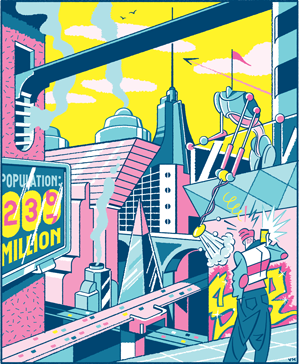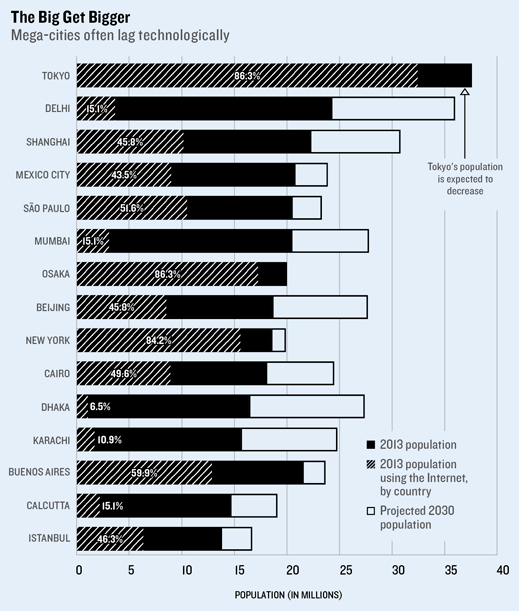Cities Find Rewards in Cheap Technologies
Cities around the globe, whether rich or poor, are in the midst of a technology experiment. Urban planners are pulling data from inexpensive sensors mounted on traffic lights and park benches, and from mobile apps on citizens’ smartphones, to analyze how their cities really operate. They hope the data will reveal how to run their cities better and improve urban life. City leaders and technology experts say that managing the growing challenges of cities well and affordably will be close to impossible without smart technology.

Fifty-four percent of humanity lives in urban centers, and almost all of the world’s projected population growth over the next three decades will take place in cities, including many very poor cities. Because of their density and often strained infrastructure, cities have an outsize impact on the environment, consuming two-thirds of the globe’s energy and contributing a large share of its greenhouse-gas emissions. Urban water systems are leaky. Pollution levels are often extreme.
But cities also contribute most of the world’s economic production. Thirty percent of the world’s economy and most of its innovation are concentrated in just 100 cities. Can technology help manage rapid population expansion while also nurturing cities’ all-important role as an economic driver? That’s the big question at the heart of this Business Report.
Selling answers to that question has become a big business. IBM, Cisco, Hitachi, Siemens, and others have taken aim at this market, publicizing successful examples of cities that have used their technology to tackle the challenges of parking, traffic, transportation, weather, energy use, water management, and policing. Cities already spend a billion dollars a year on these systems, and that’s expected to grow to $12 billion a year or more in the next 10 years.
To justify this kind of outlay, urban technologists will have to move past the test projects that dominate discussions today. Instead, they’ll have to solve some of the profound and growing problems of urban living. Cities leaning in that direction are using various technologies to ease parking, measure traffic, and save water (see “Sensing Santander”), reduce rates of violent crime (see “Data-Toting Cops”), and prepare for ever more severe weather patterns.
There are lessons to be learned, too, from cities whose grandiose technological ideas have fallen short, like the eco-city initiative of Tianjin, China (see “China’s Future City”), which has few residents despite great technology and deep government support.
The streets are similarly largely empty in the experimental high-tech cities of Songdo, South Korea; Masdar City, Abu Dhabi; and Paredes, Portugal, which are being designed to have minimal impact on the environment and offer high-tech conveniences such as solar-powered air-conditioning and pneumatic waste disposal systems instead of garbage trucks. Meanwhile, established cities are taking a much more incremental, less ambitious, and perhaps more workable approach, often benefiting from relatively inexpensive and flexible digital technologies.
Since its launch in 2010, the Mayor’s Office of New Urban Mechanics in Boston has focused on small-scale initiatives that exploit technology and data, aiming to pull people into a practice it calls “participatory urbanism.”
The office’s first project was Citizens Connect, a digital hotline that allows people to use their smartphones to report trash, graffiti, and service problems to City Hall. Since then, the office has rolled out City Worker, which helps municipal employees track their daily tasks and report progress to their bosses and to citizens. Pilot programs are testing mobile parking ticket payments, smart parking meters, pothole reporting, and sensors in streets that would alert drivers to open parking spaces.

City Worker is the reason why, one sunny September afternoon, John Schallmo was taking a picture of an empty brick sidewalk on his Android phone. Schallmo, a 30-year Boston city employee, was in the brownstone-lined South End to document the cleanup of a pile of crumpled papers and plastic bags. The mess had been reported through Citizens Connect, and with the trash cleaned up, the photo evidence would be sent to the person who had notified the city, proof that he or she had made a difference. The photo would go, too, into a series of departmental maps tracking crew locations, pothole reports, and other problems.
Technology has had its failures in Boston. A text version of Citizens Connect was a dud. And registering potholes and trash may seem relatively mundane, even futile, in streets that are marred by broken pavement and litter. But Nigel Jacob and Chris Osgood, directors of the Office of New Urban Mechanics, say these small steps build greater trust between the public and government, creating a platform to take on bigger challenges in education and housing.
In the developing world, where most of the urban growth has come in recent years, mobile technologies offer a cost-effective way of managing environmental and civic challenges that figure to worsen (see “Booming Lagos, Smart City”).
In India, where the urban population is predicted to increase from 31 percent of the total to 38 percent by 2026, Prime Minister Narendra Modi plans to invest $1.2 billion in 100 new and retrofitted smart cities. But in the western textile city of Surat, population five million, relatively inexpensive technology is making the greatest difference. A flood warning system uses temperature, rainfall, wind speed, and other data captured by new automated weather stations, combined with information from river gauges, satellites, and other sources, to create models of the nearby Tapti River and Ukai reservoir. It cost less than $500,000 to set up, plus some land donated by the city, but the system was able to warn citizens two days before floods struck during the 2013 rainy season, giving them time to buy groceries and drive to high ground. A second project, connecting health workers around the region to centralized data via the Internet and SMS, has helped the health department predict outbreaks of malaria, viral hepatitis, dengue fever, and leptospirosis and take action to prevent their spread.
Technology is not just a tool cities can use to manage their tremendous growth; it’s a big part of what’s driving it, too. Harvard economist Edward Glaeser, author of The Triumph of the City, argues that following a century of technological innovations that made distance less important, from the automobile to video games, technology has more recently begun to boost cities by creating a more “idea-intensive and complicated world.” As social beings, we tackle these challenges especially well in close proximity to one another. Technology is “moving us toward an economy that very much rewards intelligence and innovation,” says Glaeser, “and that moves us in the direction of urbanization.”
Keep Reading
Most Popular
Large language models can do jaw-dropping things. But nobody knows exactly why.
And that's a problem. Figuring it out is one of the biggest scientific puzzles of our time and a crucial step towards controlling more powerful future models.
The problem with plug-in hybrids? Their drivers.
Plug-in hybrids are often sold as a transition to EVs, but new data from Europe shows we’re still underestimating the emissions they produce.
Google DeepMind’s new generative model makes Super Mario–like games from scratch
Genie learns how to control games by watching hours and hours of video. It could help train next-gen robots too.
How scientists traced a mysterious covid case back to six toilets
When wastewater surveillance turns into a hunt for a single infected individual, the ethics get tricky.
Stay connected
Get the latest updates from
MIT Technology Review
Discover special offers, top stories, upcoming events, and more.